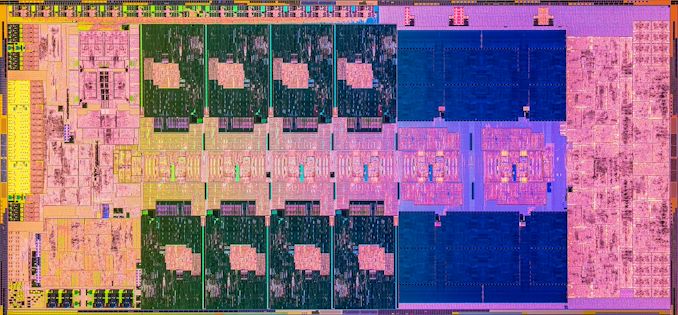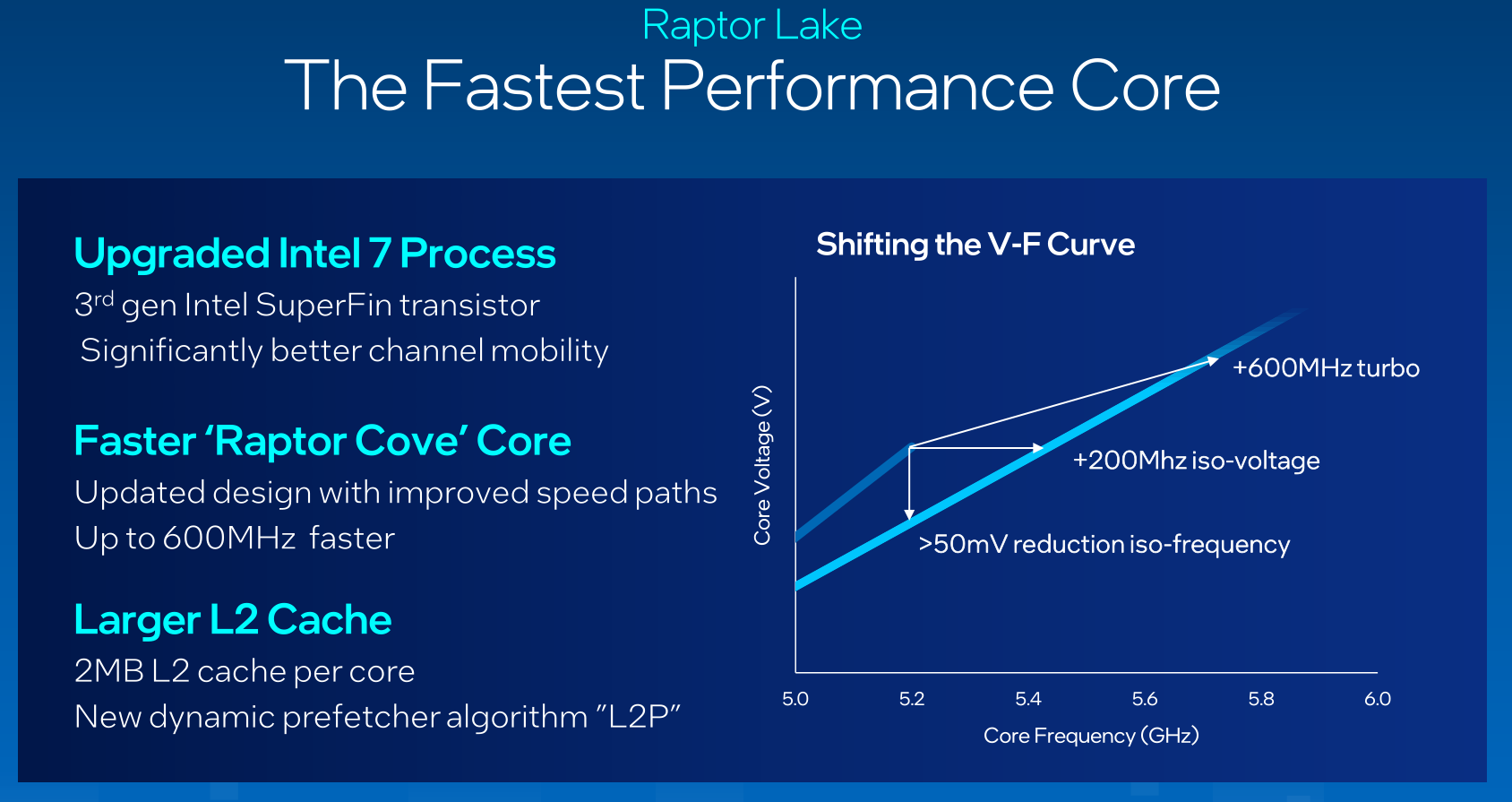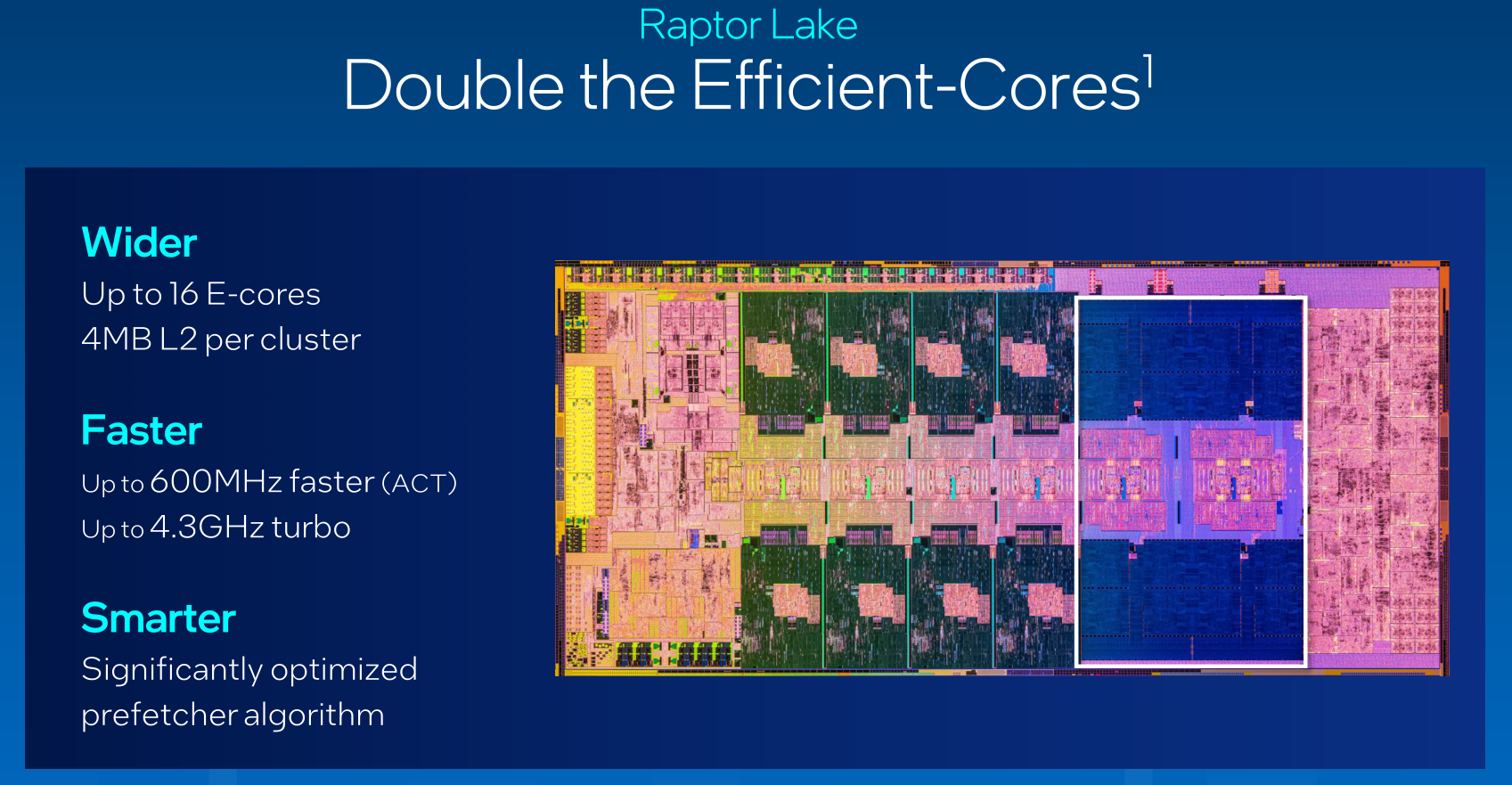Intel Core i9-13900K and i5-13600K Review: Raptor Lake Brings More Bite
by Gavin Bonshor on October 20, 2022 9:00 AM ESTRaptor Lake In Detail: Raptor Cove P-Cores, More Efficiency Cores
When it comes to architecturally dissecting the differences between Intel’s Alder Lake and Raptor Lake processors, both are based on a similar process. Intel’s 12th Gen Core (Alder Lake) series and the latest 13th Gen Core (Raptor Lake) are based on its Intel 7 manufacturing processor, although this isn’t to be confused with 7 nm, as Intel 7 is a 10 nm process node. This means that Raptor Lake isn't a new core so to speak, especially not a redesign of its existing 10ESF core, but more augmentation. Intel has opted for improvements to its underlying memory and cache structures.

Intel Raptor Lake Core die image (Core i9-13900K)
The new Raptor Cove performance (P) cores replace the previous Golden Cove variants, with Intel specifying that Raptor Cove is based on an ‘enhanced’ version of its Intel 7 process using its 3rd generation of SuperFin transistor. With this newly optimized process combined with a better overall VF curve over the last age, Intel hopes to leverage the benefit from a higher frequency without increasing power levels too much.
Focusing on changes to the cache, the 13th Gen Core series has more L2 cache. For the new Raptor Cove core, Intel has added more L2 cache when compared to Alder Lake, with 1.6x more with 2 Mb per P-core. The levels of L2 cache assigned to each array of E-cores now equates to 4 Mb; up from 2 Mb. This means Intel has improved the L2 cache on both core types. For the L3 cache, Intel hasn't made any strides and has left things unchanged.
Adjusting to the Voltage Frequency (VF) cure has allowed Intel to squeeze out even more gains about frequency versus voltage. In the case of Raptor Lake, Intel has managed to increase the peak P-Core frequency by a significant amount, up to 1 GHz in some cases. An example is the Core i9-13900K which has a maximum turbo frequency of up to 5.8 GHz; this equates to just over 11.5% over the Core i9-12900K. As per the released V/F curve optimizations, Intel has managed to eke out 200 MHz at ISO-Voltage, with a reduction of 50 mV at ISO frequency.
One thing to highlight about Intel’s 13th Gen Core series processors is the discrepancy between the base TDP, which for its entire launched stack (as of 10/20) is 125 W. The turbo or PL2 values are the same for the Core i9 and Core i7 models which are set at 253 W. This is an increase of 12 W from the corresponding 12th Gen Core i9 chips (241 W), and up by 63 W on the Core i5 series like for like. With the element of adding double the amount of E-cores, even with a more efficient V/F curve, there had to be tradeoffs when it came to power.
Raptor Lake and E-Cores: Same Gracemont Cores, Just More of Them
As we reviewed the previous generations of Intel Core i9-12900K processors, Intel has kept the same Gracemont-based Efficiency (E) core for Raptor Lake. The key difference when comparing the flagships of both generations, the Core i9-13900K has double the amount of E-cores compared to the previous generation. The doubling of E-cores in combination with the refined Raptor Cove core design for the P-cores means that the Core i9-13900K now has a total of 24-cores, with other SKUs benefitting from an increase in E-cores too.
Still, even with double the E-cores, the power penalty for doing this shouldn’t be an issue, at least not from a cooling perspective. As is with a high-performance processor and the high PL1/PL2 power it needs to stretch its legs, premium cooling would never go a miss. Intel isn’t officially recommending a minimum limit to cooling, but a low-performance cooler will almost guarantee thermal throttling as the Thermal Velocity Boost (TVB) for 13th Gen is set to 70°C.
In addition to the changes above, Intel’s 13th Gen Core series (unlike AMD’s Zen 4) offers support for both DDR5 and DDR4 memory. Further to the previous 12th Gen, the 13th Gen now supports faster DDR5 memory (DDR5-5600 versus DDR5-4800), an increase of 16.6%. Bandwidth and speeds for DDR4 memory remain at 3200 MT/s. Still, it allows users to match a lower-value processor without paying over the odds for DDR5 memory, which should decrease in price over time (hopefully).
Intel Thread Director: Windows 11 22H2 (or Newer) is Recommended
Since Intel’s 12th Gen Core series launch late last year, there was much furor around task scheduling in combination with Intel’s (new at the time) Thread Director built into the cores. While there were clear issues with Thread Director in combination with Windows 10, the Windows 11 operating system alleviated the issue of parking high single-threaded workloads on cores that otherwise wouldn’t be the best option (E-Cores). Although Windows 10 did in essence work with Intel Thread Director, it wasn’t really good at highlighting efficiency, and this is where Windows 11 came into play for optimal performance with Alder Lake.
Fast forward to now, and with all the additional E-cores in play with Raptor Lake, the latest update at the time of writing, Windows 11 22H2, offers the latest enhancements in the partnership between Intel, Microsoft, and the inner workings of Intel’s Thread Director. With a hybrid architecture and non-optimized software, it makes things a bit of a mess, but as per Intel’s guidance, they do recommend users use Windows 11 with 22H2 (or newer) for optimum performance when using 13th Gen Core series processors.
Over the next page is more information about the latest Z790 chipset which accompanies the Raptor Lake processors with this launch. From then on in, we'll detail our new CPU suite for 2023 and beyond, as well as see if Intel's 13th Gen Core Raptor Lake series can take a bite out of the competition. The associated pages and their contents are highlighted below:












169 Comments
View All Comments
brucethemoose - Thursday, October 20, 2022 - link
x264 is (more or less) the same thing as the handbrake test... and it kinda is legacy software at this point.Personally, I'd like to see a more modern encoding test, like av1an with x265+chunked encoding, or maybe Staxrip with some filters enabled. Reply
GeoffreyA - Thursday, October 20, 2022 - link
Yes, some libaom would be fantastic. Replyjakky567 - Monday, October 24, 2022 - link
I wouldn't say handbrake/x264 are obsolete yet. We should be looking towards the future, but h264 is here to stay as at least a fallback codec. ReplyGeoffreyA - Tuesday, October 25, 2022 - link
It is very much the MP3 of video and here to stay. Plus, its successors have not been indisputably better or have come with tradeoffs. ReplyAshantus - Thursday, October 20, 2022 - link
Comparing the performance of 7600X vs 13600k i see some overall advantage for the 13600K.But, i will defionitly go for the 7600X due one argue.
Load Consumption of 134 Watt vs 238 Watt at almost same performance is something.
Regarding the poweer costs in europe of 60 cent per Watt that is quiet some pricing argue at a 5 years lifetime.
At anandtech:
this argue should be mentioned in your closing thoughts. 100 Watt more powerconsumption at todays powerprices is a serious issue. Reply
Yojimbo - Thursday, October 20, 2022 - link
I don't remember seeing power versus performance numbers. Did I miss them? ReplyCiccioB - Thursday, October 20, 2022 - link
<blockquote>Load Consumption of 134 Watt vs 238 Watt at almost same performance is something.</blockquote>This thought is completely wrong. It is called "induction", as you were looking at something and then reported that on something else.
You see a graph of power consumption for a "unlimited test" (where performance is not measured) and then you think that that measure is valid also for other tests.
So you just think that for each bench those CPUs consume always those Watts (how can it be?) and that the performance are the same (where did you got that? In almost all benches the 13600K leaves the 7600X in the dust, but not knowing their power consumption for those test you cannot say which is the most efficient). Reply
Ashantus - Thursday, October 20, 2022 - link
Just found another test, whereas a powerconsumption at action is recorded.At gaming (average out of 12 games tested) is:
13600k = 88 W. 7600X = 60 W
13990K = 144 W 7900X = 107W Reply
Yojimbo - Thursday, October 20, 2022 - link
that looks more plausible. but it is also mostly useless except in the context of the specific workload. modern cpu performance testing is very complicated and performance versus power should be taken in the specific workload one is interested in, or at the very least an average of workloads of a similar type. ReplyGastec - Sunday, October 23, 2022 - link
Specific workload such as : 13990K produces 100 fps @ 144 W, while 7600X produces 100 fps @ 60 W? Reply